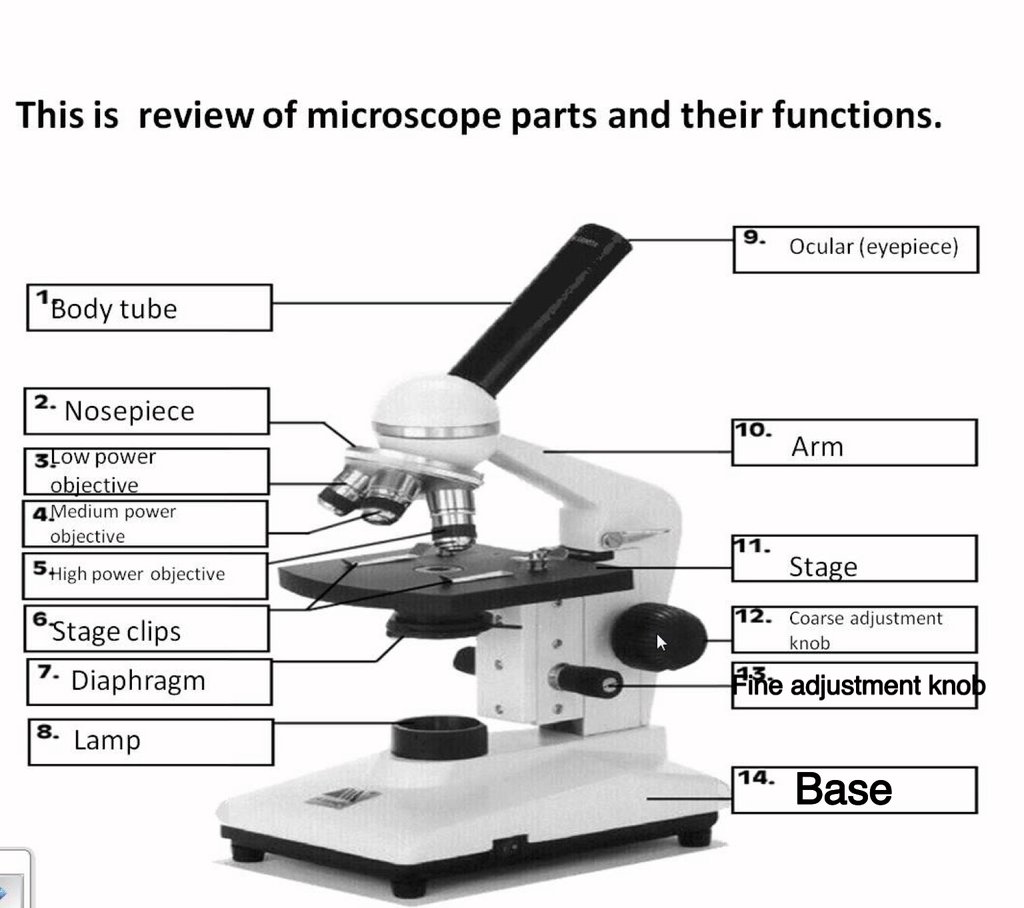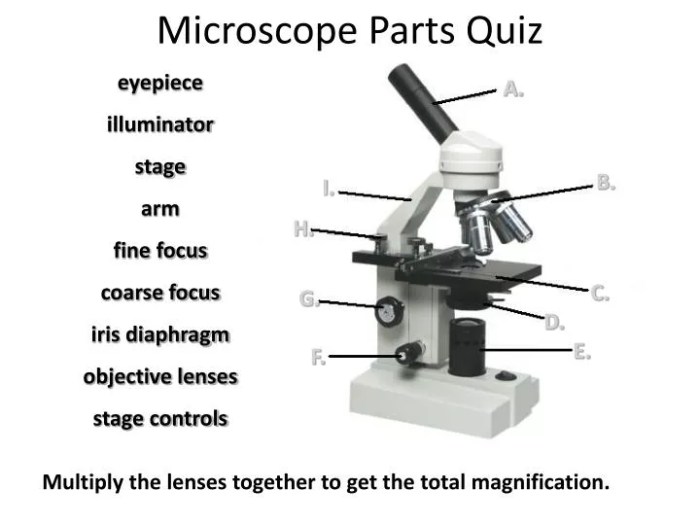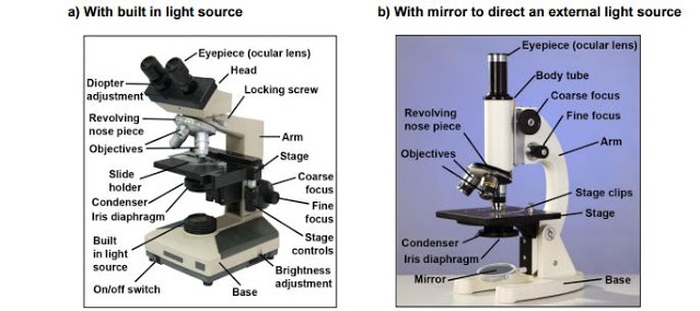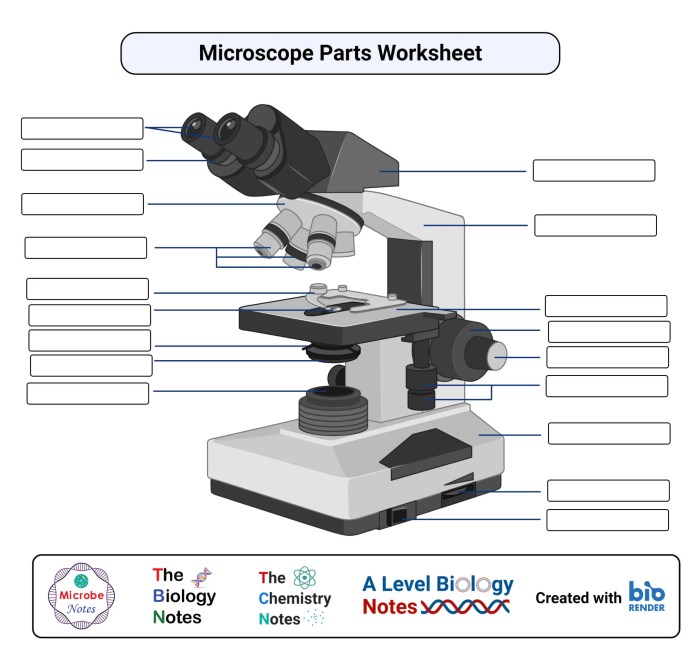Embark on an enlightening journey into the realm of microscopy with our comprehensive Compound Light Microscope Parts Quiz. This engaging assessment not only tests your knowledge but also deepens your understanding of the intricate components that make up this indispensable scientific instrument.
Prepare to unravel the secrets of magnification, illumination, and specimen manipulation as you navigate through a series of thought-provoking questions. By the end of this quiz, you will emerge as a microscopy maestro, equipped with a profound appreciation for the intricate workings of the compound light microscope.
Microscope Parts
A compound light microscope is a scientific instrument that uses lenses to magnify small objects. It is widely used in various fields such as biology, chemistry, and medicine for examining cells, microorganisms, and other tiny structures.
The different parts of a compound light microscope and their functions are as follows:
Eyepiece
- Located at the top of the microscope, the eyepiece is used to view the magnified image.
- It typically has a magnification of 10x or 15x.
Objective Lenses
- Mounted on a rotating turret, objective lenses provide different levels of magnification.
- Common magnifications include 4x, 10x, 40x, and 100x (oil immersion).
Condenser
- Located below the stage, the condenser focuses light onto the specimen.
- It helps to improve the contrast and resolution of the image.
Diaphragm
- Located below the condenser, the diaphragm controls the amount of light passing through the specimen.
- Adjusting the diaphragm can improve the clarity of the image.
Stage
- The stage is the platform where the specimen is placed.
- It can be moved up and down to focus the image.
Coarse and Fine Focus Knobs
- Located on the side of the microscope, these knobs are used to adjust the focus of the image.
- The coarse focus knob is used for large adjustments, while the fine focus knob is used for precise adjustments.
Illuminator
- The illuminator provides light for the microscope.
- It can be a built-in light source or an external light source.
Labeled Diagram
Refer to the attached diagram for a labeled representation of the parts of a compound light microscope.
Microscope Usage: Compound Light Microscope Parts Quiz

The compound light microscope is a versatile tool that can be used to view a wide variety of specimens. To use a compound light microscope properly, it is important to follow these steps:
- Prepare the specimen.The specimen should be thin enough to allow light to pass through it. If the specimen is too thick, it will be difficult to see.
- Place the specimen on the stage.The specimen should be placed in the center of the stage.
- Focus the microscope.Start by using the coarse focus knob to bring the specimen into rough focus. Then, use the fine focus knob to fine-tune the focus.
- Adjust the lighting.The amount of light that is used to illuminate the specimen can be adjusted using the diaphragm. The diaphragm is located below the stage.
- View the specimen.Once the specimen is in focus, you can view it through the eyepieces.
Preparing and Viewing Specimens Under a Microscope
When preparing a specimen for viewing under a microscope, it is important to keep the following in mind:
- The specimen should be thin enough to allow light to pass through it.
- The specimen should be placed on a slide and covered with a coverslip.
- The slide should be placed on the stage of the microscope.
Once the specimen is prepared, it can be viewed under the microscope. The following steps can be followed to view a specimen under a microscope:
- Start by using the coarse focus knob to bring the specimen into rough focus.
- Then, use the fine focus knob to fine-tune the focus.
- Adjust the lighting using the diaphragm.
- View the specimen through the eyepieces.
Microscope Maintenance
Regular maintenance is essential for the longevity and optimal performance of a compound light microscope. Proper care ensures accurate observations, extends the microscope’s lifespan, and minimizes the risk of damage.
Cleaning the Microscope, Compound light microscope parts quiz
- Ocular Lenses:Use a soft lens brush or lens paper to gently remove dust and debris. Avoid using harsh chemicals or abrasive materials.
- Objective Lenses:Use lens paper or a cotton swab dipped in lens cleaning solution to carefully clean the lens surfaces. Wipe in a circular motion from the center outward.
- Condenser:Clean the condenser lens with a soft cloth or lens paper. Remove any dust or debris that may obstruct the light path.
- Stage:Wipe the stage with a damp cloth to remove any spills or contaminants.
- Exterior:Use a soft, dry cloth to wipe down the microscope’s exterior surfaces, including the base, arm, and eyepiece tubes.
Microscope Applications

Compound light microscopes are widely used in various fields of study to examine specimens and gather valuable information. These microscopes enable scientists and researchers to explore the intricate details of cells, tissues, and other microscopic structures.
Biological Sciences
In biological sciences, compound light microscopes are indispensable tools for studying cells, microorganisms, and tissues. They are used in fields such as:
- Cytology:Studying the structure and function of cells
- Microbiology:Examining microorganisms like bacteria, viruses, and fungi
- Histology:Investigating the microscopic structure of tissues
- Embryology:Studying the development of embryos
Medical Sciences
In medical sciences, compound light microscopes are crucial for diagnosing and treating diseases. They are used in:
- Pathology:Examining tissues to identify abnormal cells and diagnose diseases
- Microbiology:Identifying microorganisms responsible for infections
- Forensic science:Analyzing evidence in criminal investigations
Materials Science
In materials science, compound light microscopes are used to investigate the microstructure of materials. They are employed in:
- Metallurgy:Studying the structure and properties of metals
- Ceramics:Analyzing the microstructure of ceramic materials
- Polymer science:Examining the morphology and properties of polymers
Other Applications
Beyond these primary fields, compound light microscopes are also utilized in:
- Environmental science:Studying microorganisms in water and soil
- Food science:Inspecting food products for contamination and quality
- Education:Teaching students about cell biology and microscopy
Microscope Troubleshooting

Microscope troubleshooting involves identifying and resolving issues that may arise during the operation of a compound light microscope. Common problems include poor image quality, mechanical malfunctions, and illumination issues. Troubleshooting these problems requires a systematic approach to identify the root cause and implement appropriate solutions.
Identifying Common Problems
- Blurry or out-of-focus images
- Uneven or insufficient illumination
- Mechanical problems, such as stage movement issues or condenser misalignment
- Electrical issues, such as power supply failures or faulty components
Troubleshooting Solutions
- Blurry or out-of-focus images:Check the focus knobs, adjust the coarse and fine adjustments, and ensure the specimen is properly prepared.
- Uneven or insufficient illumination:Adjust the condenser height and position, check the light source intensity, and clean the optical components.
- Mechanical problems:Inspect the mechanical components for damage or misalignment, lubricate moving parts, and tighten any loose screws.
- Electrical issues:Check the power supply, inspect the electrical connections, and replace any faulty components.
By following these troubleshooting steps, users can identify and resolve common problems with compound light microscopes, ensuring optimal performance and accurate observations.
Quiz

To assess understanding of compound light microscope parts and their functions, a quiz can be administered.
The quiz should include questions that test knowledge of the following:
- Identification of microscope components
- Understanding of the function of each component
- Application of microscope parts in microscopy techniques
Answer Key
The answer key should provide the correct answers to each question in the quiz, along with a brief explanation or justification for each answer.
General Inquiries
What is the function of the condenser in a compound light microscope?
The condenser focuses light onto the specimen, controlling the intensity and angle of illumination.
What is the purpose of the diaphragm in a compound light microscope?
The diaphragm regulates the amount of light passing through the specimen, enhancing contrast and resolution.
What is the difference between the coarse and fine focus knobs on a compound light microscope?
The coarse focus knob makes large adjustments to bring the specimen into approximate focus, while the fine focus knob makes precise adjustments for optimal clarity.